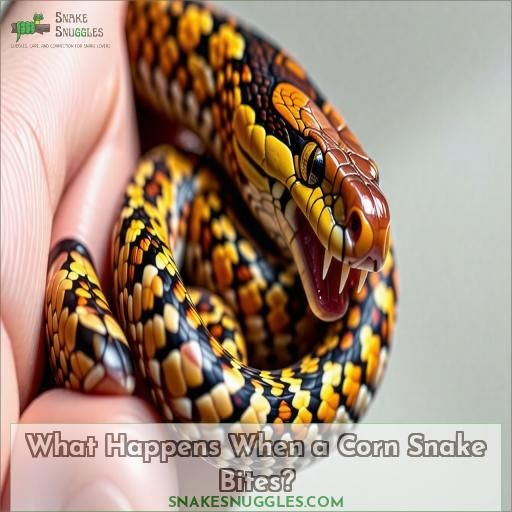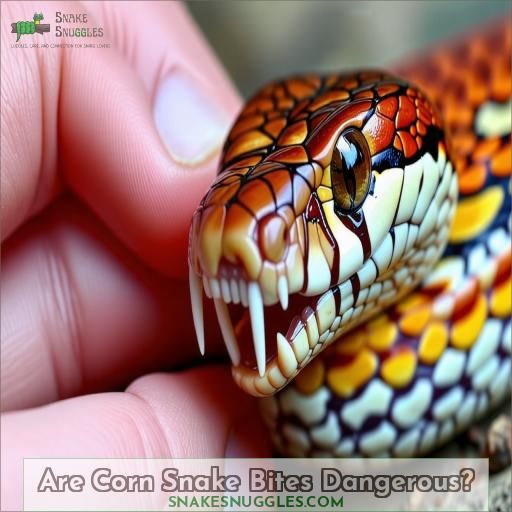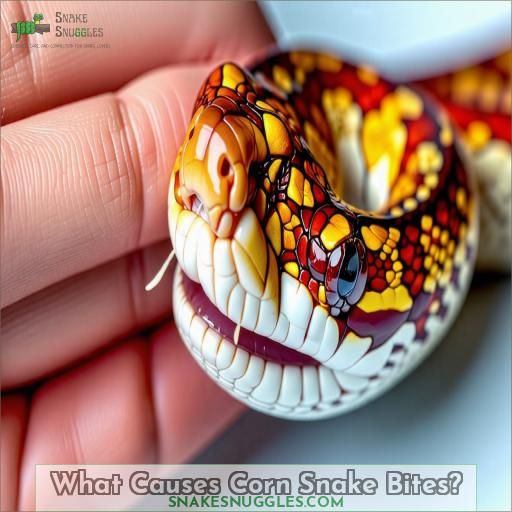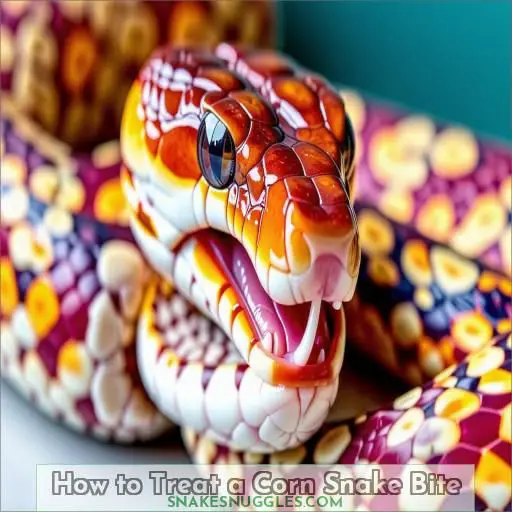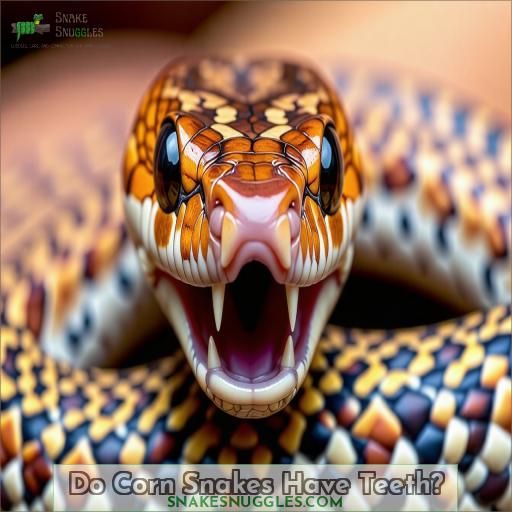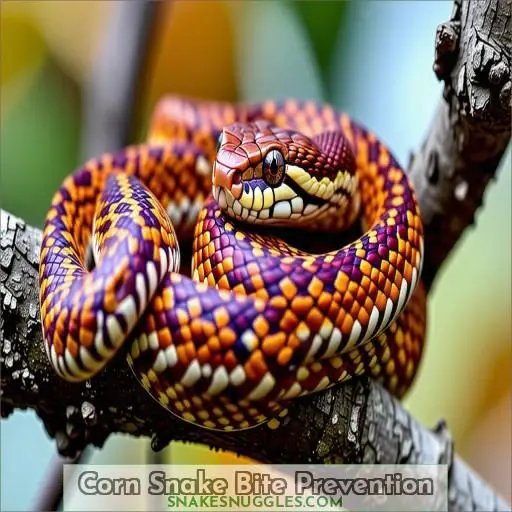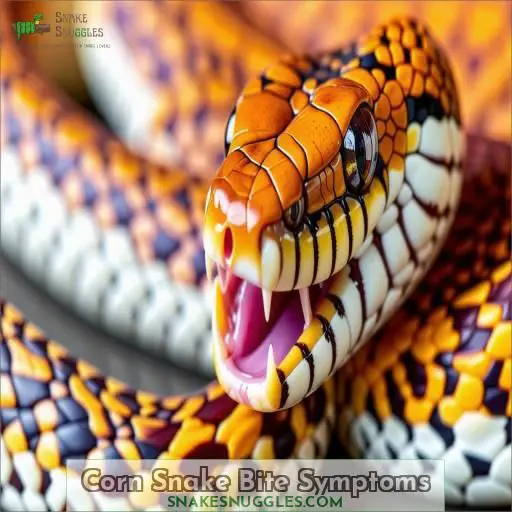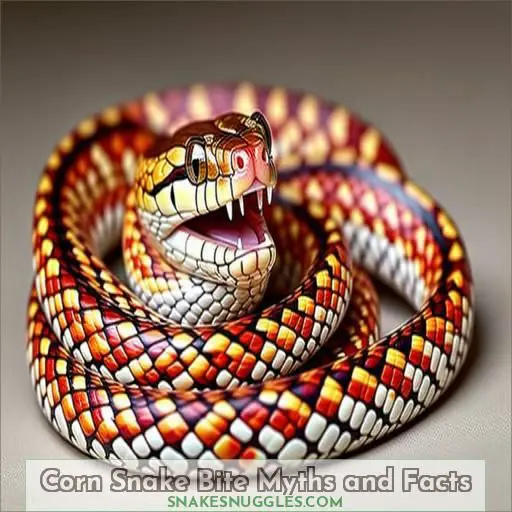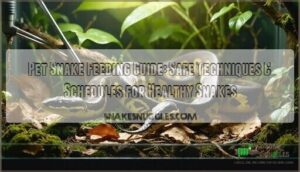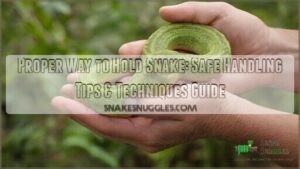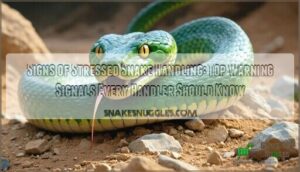This site is supported by our readers. We may earn a commission, at no cost to you, if you purchase through links.
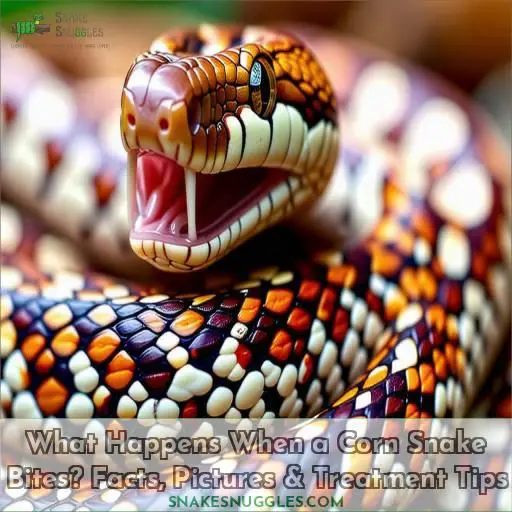 If a corn snake bites you, you’ll experience small puncture wounds and minor bleeding from its tiny teeth, but no long-term health effects.
If a corn snake bites you, you’ll experience small puncture wounds and minor bleeding from its tiny teeth, but no long-term health effects.
Corn snakes are non-venomous, so their bites pose no serious risks – they rely on constriction to subdue prey.
Bites often result from sudden movements, shedding stress, hunger, or poor handling technique.
Remain calm if bitten, gently unwind the snake if constricted, then give it space.
Apply a bandage if needed, but symptoms are typically mild discomfort.
With proper care and understanding, you’ll find that corn snake bites, while uncomfortable, are manageable incidents.
Their bites’ appearance and treatment reveal more about these fascinating reptiles.
Table Of Contents
- Key Takeaways
- What Happens When a Corn Snake Bites With Pictures and Facts?
- What Happens When a Corn Snake Bites?
- Are Corn Snake Bites Dangerous?
- What Causes Corn Snake Bites?
- What Do Corn Snake Bites Look Like?
- How to Treat a Corn Snake Bite
- Do Corn Snakes Have Teeth?
- Corn Snake Bite Prevention
- Corn Snake Bite Symptoms
- Corn Snake Bite Myths and Facts
- Frequently Asked Questions (FAQs)
- Are corn snake bites harmful?
- Do corn snakes have teeth?
- What are corn snakes quick facts?
- What is the biggest trouble with corn snakes?
- Can corn snakes bite through thick gloves?
- Do corn snake bites leave scars?
- How long do corn snake bites take to heal?
- Can corn snake bites cause allergic reactions?
- Do corn snakes bite more than other pet snakes?
- Conclusion
Key Takeaways
- Corn snake bites cause small puncture wounds and minor bleeding due to their tiny teeth, but no long-term health effects since they are non-venomous constrictors
- Bites often result from sudden movements, shedding stress, hunger, or poor handling technique, so remaining calm, gently unwinding the snake if constricted, and giving it space is important
- Corn snakes have small, sharp teeth used for grasping and holding prey during constriction, which can lead to the puncture wounds if they bite
- Avoiding sudden movements around snakes, handling them gently to minimize stress, and ensuring they are well-fed in a familiar environment can greatly reduce the risk of bites
What Happens When a Corn Snake Bites With Pictures and Facts?
When a corn snake bites, it typically causes mild discomfort and small puncture wounds from its tiny teeth. Corn snake bites aren’t dangerous, as they’re non-venomous and rely on constriction to capture prey.
What Happens When a Corn Snake Bites?
When a corn snake bites, you’ll experience mild discomfort and small puncture wounds. Though the tiny teeth may cause some minor bleeding, these non-venomous snakes pose no serious health risks from their bites.
Mild Discomfort and Small Puncture Wounds
When a corn snake bites, you may experience mild discomfort and small puncture wounds. These bites aren’t dangerous, but it’s crucial to handle snakes gently to avoid startling them. If bitten, remain calm, gently remove the snake, and clean the wound with soap and water. Seek medical attention if the bite causes significant pain or swelling.
Possible Bleeding From Tiny Teeth
Corn snakes have small, sharp teeth that can cause minor bleeding when they bite. The puncture wounds from their teeth are usually shallow and heal quickly. While bleeding is possible, it’s typically minimal due to the small size and shape of their teeth. Proper first aid can help stop any bleeding and prevent infection after a corn snake bite.
No Long-term Health Effects
While corn snake bites may cause temporary discomfort and small puncture wounds, there are typically no long-term health consequences.
Proper first aid, including cleaning the wound and applying a bandage if needed, is usually sufficient.
However, some individuals may experience psychological distress after a bite.
Practicing safe handling and bite prevention strategies is key to minimizing the risk and impact of corn snake bites.
Are Corn Snake Bites Dangerous?
Corn snakes are non-venomous and rely solely on constriction to capture prey. Their bites pose no risk of envenomation, as they don’t possess venom glands or toxins.
Non-venomous
When a Corn snake bites, rest assured, it’s non-venomous, lacking venom glands and posing no risk of envenomation. These bites typically result in mild discomfort, small puncture wounds, and possible bleeding – but no toxins are present. Corn snakes, like their non-venomous relatives, rely on constriction to capture prey, making them fascinating creatures found in regions like Florida.
Rely on Constriction to Capture Prey
Corn snakes are non-venomous constrictors that rely on constriction to capture prey.
Their small, sharp teeth are designed for grasping and holding prey, not injecting venom.
When a corn snake bites, it may cause mild discomfort and small puncture wounds, but there’s no risk of envenomation or serious harm to humans.
Proper handling and habitat maintenance can minimize the chances of a bite occurring.
No Risk of Envenomation
Corn snakes lack venom glands and don’t possess fangs, so their bites pose no risk of envenomation. They rely solely on constriction to subdue prey. A corn snake bite may cause mild discomfort and small puncture wounds, but no long-term health effects. To avoid bites, handle snakes gently, minimize stress, and make sure they’re well-fed in a familiar environment .
What Causes Corn Snake Bites?
Corn snakes may bite due to various reasons – sudden movements, shedding stress, hunger, poor handling techniques, overhandling, unfamiliar environments, or underlying health issues can provoke defensive bites. It’s imperative to understand these potential causes to prevent bites and guarantee proper care for these non-venomous snakes.
Sudden Movement
Sudden movements around corn snakes can trigger a fear response, causing them to bite defensively.
To avoid this, move slowly and deliberately when handling or approaching them.
Provide environmental enrichment like hiding spots to reduce stress.
Always supervise children interacting with corn snakes and never grab them suddenly.
Proper snake handling techniques are essential for safety and to prevent bites caused by sudden movements.
Shedding Stress
When a corn snake experiences shedding stress due to the shedding process, shedding behavior, or shedding enclosure, it may become more irritable and prone to defensive behaviors, including biting.
The shedding frequency and habits of corn snakes can impact their stress levels during this natural process.
It’s important to handle them gently and minimize any additional stress during shedding to reduce the likelihood of bites .
Stress From Other Sources
Stress from other sources can also trigger biting in corn snakes.
Make certain the snake’s environment is familiar and suitable for its needs.
Handle it gently and minimize stress to avoid aggressive behavior.
Adequately feed the snake and maintain its health to prevent biting incidents.
Seek veterinary care if you observe any signs of distress or health issues to mitigate stress-induced aggression.
Hunger
Hunger can also trigger defensive bites in corn snakes. If a snake is hungry and you attempt to handle it, it may mistake your hand for food and strike. Make certain your corn snake is well-fed and on a consistent feeding schedule to minimize the risk of hunger-related bites. Proper care and environment are key to safe handling.
| Cause | Description |
|---|---|
| Hunger | Corn snakes may mistake your hand for food if hungry and strike defensively. Make certain proper feeding schedule. |
| Handling | Avoid handling snakes when hungry to prevent bites mistaken for prey. |
| Environment | Provide a suitable habitat to keep corn snakes calm and less likely to bite out of stress. |
Poor Handling Technique
Improper handling is a common cause of corn snake bites. Always approach your snake calmly, avoid sudden movements, and use gentle, respectful handling techniques. Support their body fully, keep them close to the ground, and never grab them by the tail. With patience and care, you can safely interact with your corn snake and prevent bites caused by poor handling.
Overhandling
Overhandling your corn snake can lead to stress and aggression. Limit handling to essential care and minimize time outside the enclosure. Watch for signs of stress like refusing food or hiding constantly. Provide plenty of hides and keep the environment stable. Respect your snake’s boundaries and you’ll build a positive relationship based on trust and comfort in a familiar setting .
Unfamiliar Environment
If you recently relocated your corn snake to a new habitat, it may feel stressed and more likely to bite.
Allow your snake ample time to adjust to its unfamiliar environment.
Provide environmental enrichment like hiding spots and clutter to help it feel secure.
With patience and care, your snake will acclimate to its new home and be less likely to strike out of fear.
Health Issues
To prevent corn snake bites due to health issues, guarantee your snake’s overall well-being. Follow these key practices:
- Monitor snake health closely, watching for any signs of illness or discomfort.
- Provide proper environmental enrichment, including suitable hides and climbing structures.
- Seek immediate veterinary care if you observe any unusual behavior, appetite changes, or other concerning symptoms related to snake health .
What Do Corn Snake Bites Look Like?
When a corn snake bites, you’ll notice small puncture wounds caused by its tiny, sharp teeth. While there may be minor bleeding initially, you won’t see any swelling or redness, as corn snake bites aren’t venomous and cause only mild discomfort.
Small Puncture Wounds
Corn snake bites typically result in small, round puncture wounds from their tiny teeth. While not deep, these wounds may bleed slightly. Proper wound cleaning with soap and water, followed by an antiseptic, is essential to prevent infection. Pain is minimal, and scarring is rare. However, the psychological impact of being bitten can be significant for some individuals.
Possible Bleeding
Corn snake bites may cause minor bleeding due to their small, sharp teeth. However, the bleeding is typically minimal and should stop quickly as the wound begins to clot. To prevent infection, clean the bite area with soap and water, apply an antiseptic, and monitor for signs of infection. Scarring is uncommon with proper wound care.
No Swelling or Redness
When a corn snake bites, you may notice small puncture wounds from its tiny teeth, but swelling and redness are uncommon. To treat a corn snake bite:
- Clean the wound with soap and water to prevent infection
- Apply an antiseptic if desired
- Cover with a bandage if bleeding persists
- Monitor for signs of infection like increased pain, redness, or swelling
Corn snake bites aren’t dangerous and typically cause only mild discomfort. Seek medical attention if you have concerns about the bite or your health.
How to Treat a Corn Snake Bite
If a corn snake bites you, remain calm and still to avoid provoking further defensive behavior. Gently unwind the snake if it has constricted around your limb, give it space to calm down, and apply a bandage if the small puncture wounds are bleeding.
Remain Calm and Still
When handling a corn snake bite, it’s imperative to remain calm and still to prevent further agitation to the snake and to yourself. This helps minimize the risk of the situation escalating. By remaining calm, you create a safer environment for both you and the snake. It’s important to remember that the snake’s behavior is largely influenced by your own approach when dealing with a bite incident.
| Advantages | Disadvantages |
|---|---|
| Helps maintain a safe environment | Can be challenging in an emergency context |
| Minimizes the risk of escalation | Requires self-control and composure |
Gently Unwind the Snake if Constricted
When dealing with a corn snake bite, it’s imperative to carefully unwind the snake if it has constricted around you.
Avoid abrupt movements, as it may worsen the situation.
Make sure that you approach the snake with caution and move gradually to prevent any further distress.
Handling procedures in such situations should be calm and systematic.
Safety precautions are essential to prevent unintentional harm to the snake or yourself.
Give the Snake Space
After a bite, give your corn snake space to unwind in its enclosure and avoid handling for a while if you were tending the tank or feeding when it happened. Provide a quiet, dark hiding spot to help it destress. Corn snakes prefer warm, humid environments and can be found under rocks, logs, or in burrows in their natural habitat.
Apply a Bandage if Necessary
If the bite is bleeding, apply a clean bandage to the affected area. The bandage should be snug but not too tight. Avoid using tourniquets or applying ice directly to the skin. Monitor the bite for signs of infection, such as redness, swelling, or pus. Seek medical attention if symptoms persist or worsen.
Do Corn Snakes Have Teeth?
Yes, corn snakes do possess small, sharp teeth. These teeth are used for grasping and holding prey during constriction, which can result in minor puncture wounds if the snake bites.
Yes, Corn Snakes Have Small, Sharp Teeth
Yes, corn snakes have small, sharp teeth suited for grasping and holding prey.
The teeth size is relatively small, and they’re located in the upper and lower jaw.
These teeth have evolved to aid in capturing and securing prey items, contributing to the snake’s feeding behavior.
Notably, studies indicate an underestimated diversity in the shape of snake teeth, demonstrating their intricate evolutionary adaptations .
Used for Grasping and Holding Prey
Corn snakes have small, sharp teeth that are perfectly suited for grasping and holding their prey. These teeth are designed to curve backward, making it difficult for prey to escape once caught. Corn snakes continuously replace their teeth throughout their lives, ensuring they always have a sharp set ready to subdue their next meal.
Bites May Cause Small Puncture Wounds
Corn snake bites may cause small puncture wounds due to their small, sharp teeth used for grasping prey (Source). Guarantee proper pain management and wound care to reduce discomfort and infection risk. Preventing corn snake bites through gentle handling and minimizing stress is essential. Swift and effective wound care can help minimize scar formation and promote quick healing (Source).
Corn Snake Bite Prevention
You can greatly reduce the risk of corn snake bites by following a few simple steps: avoid sudden movements around your snake, as these can startle and provoke defensive bites; handle your corn snake gently and minimize stress by providing a comfortable, familiar environment and ensuring it’s well-fed.
Avoid Sudden Movements Around Snakes
Sudden movements can startle corn snakes and trigger defensive bites. Approach slowly, avoid looming over them, and don’t make quick gestures near their heads. If a snake coils defensively, back away calmly. Sudden noises, vibrations, or shadows may also provoke strikes. Respect corn snakes’ space and avoid surprising them to prevent bites and keep both you and the snake safe.
Handle Snakes Gently and Minimize Stress
When handling corn snakes, prioritize snake safety by using gentle handling techniques to minimize stress and reduce the risk of bites. Employ stress reduction methods to create a calm environment for the snake, so preventing aggressive behaviors. By ensuring proper handling and environment enrichment, you contribute to bite prevention and promote the well-being of your corn snake.
Ensure Snakes Are Well-fed and in a Familiar Environment
Guarantee your corn snake’s environment is stress-free by providing a well-designed enclosure and following proper feeding schedules. Offer hiding spots, temperature gradients, and humidity levels that meet the snake’s needs. Avoid overhandling and only interact when necessary. Proper snake husbandry minimizes stress and reduces the likelihood of defensive bites. Prioritize the snake’s wellbeing for a calm, healthy pet.
Seek Veterinary Care if a Bite Occurs
If a corn snake bites you, seek veterinary care immediately. While corn snake bites aren’t dangerous, they can still cause discomfort and potential infection. To prevent bites:
- Avoid sudden movements around snakes
- Handle snakes gently and minimize stress
- Make sure snakes are well-fed and in a familiar environment
Seek medical attention if a bite occurs, and follow your veterinarian’s advice for proper treatment and prevention of future incidents.
Corn Snake Bite Symptoms
When a corn snake bites, it will cause mild discomfort and small puncture wounds from its tiny, sharp teeth. While corn snake bites may occasionally cause minor bleeding, and it’s essential to monitor your snake’s overall health for signs of issues like scale rot and skin infections common corn snake health issues and symptoms, they pose no serious health risks as corn snakes are non-venomous constrictors.
Corn Snake Bite Symptoms
When experiencing a corn snake bite, you may notice mild discomfort, small puncture wounds, and possible bleeding from the tiny teeth. These symptoms typically lead to no long-term health effects. To address these symptoms, cleaning the wound with cold water, antiseptic soap, and alcohol is essential. If necessary, applying a bandage can help in the treatment and healing process.
| Corn snake size | Puncture wound treatment | Snake bite prevention |
|---|---|---|
| 2-5 feet in length | Clean with cold water, antiseptic soap, alcohol | Handle gently, avoid sudden movements |
| Corn snake temperament | Snake bite first aid | |
| Nocturnal, secretive behavior | Remain calm, unwind snake if constricted |
Mild Discomfort Levels
When a corn snake bites, you may experience mild discomfort and small puncture wounds from their tiny teeth. Bleeding is possible but not excessive. While unpleasant, corn snake bites aren’t dangerous and cause no long-term harm. Remain calm, gently remove the snake, and clean the wound to prevent infection. Seek medical attention if symptoms persist or worsen.
Treatment and First Aid
If a corn snake bites, gently unwind it using cold water or tweezers. Clean the wound with antiseptic soap and alcohol to prevent infection. Apply a bandage if needed. Consult a veterinarian if the bite is severe or you have concerns about infection or pain. With proper first aid, corn snake bites are rarely serious.
Psychological Distress Potential
When a corn snake bite occurs, individuals may experience mild discomfort and small puncture wounds, possibly leading to psychological distress in some cases (Source). This distress can stem from factors such as unfamiliar environments, health issues, shedding stress, hunger, or overhandling. Such symptoms can have varying degrees of impact and should be addressed by remaining calm, seeking the necessary first aid, and being mindful of potential psychological effects.
- Remain calm and composed
- Seek prompt first aid and care
- Consider psychological effects
- Address factors contributing to potential distress
Corn Snake Bite Myths and Facts
You may have heard myths about corn snake bites being venomous or causing serious harm, but the truth is they’re non-venomous and their bites, while potentially causing mild discomfort and small puncture wounds, don’t contain toxins and pose no risk of envenomation.
Corn Snakes Are Non-venomous
Corn snakes are non-venomous, meaning they don’t have venom glands or fangs. Their small teeth are used for grasping prey, but corn snake bites aren’t dangerous to humans. While a bite may cause mild discomfort and small puncture wounds, there’s no risk of envenomation or long-term health effects.
Bites Do Not Contain Toxins
Corn snakes, known for their non-venomous nature, possess bites devoid of toxins.
Common triggers for bites include sudden movements, shedding stress, and hunger.
These snakes rely on constriction for prey capture and exhibit nocturnal behavior.
Found in warm, humid environments like forests, fields, and swamps, corn snakes primarily feed on rodents and other small animals.
Understanding their behavior, habitat, diet, and reproduction aids in ensuring their conservation.
Bites May Cause Mild Discomfort and Small Puncture Wounds
While corn snake bites may cause mild discomfort and small puncture wounds, they aren’t dangerous.
The severity depends on the bite location and your reaction.
To treat a bite, remain calm, gently unwind the snake, and clean the wound.
Prevent bites by handling snakes gently, minimizing stress, and seeking veterinary care if needed.
Symptoms include mild discomfort and small puncture wounds, but no long-term health effects.
Frequently Asked Questions (FAQs)
Are corn snake bites harmful?
Nope, you’ll be perfectly fine – corn snakes aren’t venomous. With a bite, you may experience mild discomfort, small punctures, and potential bleeding, but no long-term effects.
Do corn snakes have teeth?
Yes, corn snakes have many short, sharp teeth perfectly suited for grasping and consuming their prey. These teeth may puncture the skin when you’re bitten, causing mild discomfort and bleeding.
What are corn snakes quick facts?
Corn snakes are non-venomous constrictors found across North America. With distinctive orange/red blotches, they’re docile pets when handled properly. Bites are rare but can cause minor punctures.
What is the biggest trouble with corn snakes?
You’re right to worry – corn snakes biting sounds scary. But relax, their bites are harmless, just discomfort and minor bleeding. Their biggest trouble? Stress from overhandling or poor conditions. With proper care and space, corn snake bites are easily avoided.
Can corn snakes bite through thick gloves?
Yes, corn snakes can bite through thin gloves. Their small teeth are sharp enough to pierce light fabrics like cotton. However, thick leather or rubber gloves provide adequate protection against their harmless bites.
Do corn snake bites leave scars?
Corn snake bites rarely leave scars. Despite their tiny fangs, these gentle constrictors only cause minor punctures that heal cleanly.
How long do corn snake bites take to heal?
Corn snake bites typically heal within 3-5 days. Clean the wound, apply antibiotic ointment, and monitor for signs of infection. With proper care, you’ll recover quickly from this minor injury.
Can corn snake bites cause allergic reactions?
Just as a siren’s call lures sailors, a corn snake’s bite could trigger an allergic reaction, provoking inflammation’s fury upon the unsuspecting victim’s body.
Do corn snakes bite more than other pet snakes?
Corn snakes aren’t more likely to bite than other pet snake species. Their calm demeanor and reluctance to bite make them ideal beginner snakes. Proper handling minimizes bite risk with any snake.
Conclusion
Ultimately, understanding what happens when a corn snake bites, including the facts, pictures, and proper treatment, can alleviate concerns. While uncomfortable punctures and bleeding may occur, their non-venomous constriction poses no severe risks. By handling them gently, minimizing stress, and seeking care if needed, you can enjoy these fascinating reptiles without undue apprehension.

